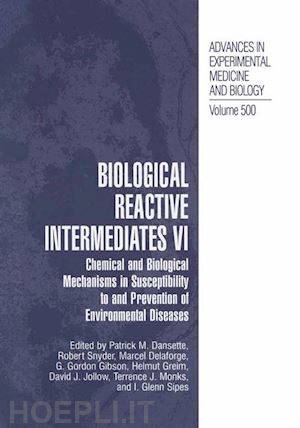Keynote Presentation; S. Orrenius, et al. Session I. Structure Activity Relationships for the Chemical Behaviour and Toxicity of Electrophilic Quinones/Quinone Methides; I.M.C.M. Rietjens, et al. Use of Structure-Activity Relationships for Probing Biochemical Mechanisms: Glutathione Transferase Zeta Conjugation of Haloacids; P.D. Swartz, A.M. Richard. Structure Toxicity Relationships - How Useful are They in Predicting Toxicities of New Drugs? S.D. Nelson. Session II. Biological Reactive Intermediates in Drug Discovery and Development A Perspective from the Pharmaceutical Industry; T.A. Baillie, K. Kassahun. Bioactiviation of Toxicants by Cytochrome P450-Mediated Dehydrogenation Mechanisms; G.S. Yost. New Aspects of DNA Adduct Formation by the Carcinogens Crotonaldehyde and Acetaldehyde; S.S. Hecht, et al. Mechanisms of Ovotoxicity Induced by Environmental Chemicals: 4-Vinylcyclohexene Diepoxide as a Model Chemical; P.B. Hoyer, et al. Mutagenicity and Carcinogenicity of Biological Reactive Intermediate's Derived A `Non-Genotoxic' Carcinogen; S.S. Lau, et al. Reactive Metabolites of 1,3-Butadiene: DNA and Hemoglobin Adduct Formation and Potential Roles in Carcinogenicity; A.A. Elfarra, et al. Chemistry and Biological Activity of Novel Selenium Containing Compounds; J.N.M. Commandeur, et al. Formation and Fate of Reactive Intermediates of Haloalkanes, Haloalkenes, and alpha-Haloacids; M.W. Anders. Short Communications. Session III. DNA Microarray Reveals Increased Expression of Thioredoxin Peroxidase in Thioredoxin-1 Transfected Cells and its Functional Consequences; B. Husbeck, et al. Reactive Nitrogen Species and Proteins: Biological Significance and Clinical Relevance; J.M. Souza, et al. Bicarbonate Enhances Nitration and Oxidation Reactionsin Biological Systems-Role of Reactive Oxygen and Nitrogen Species; B. Kalyanaraman, et al. Nitric Oxide and Peroxynitrite in Ozone-Induced Lung Injury; D.L. Laskin, et al. Antioxidant Reactions of Green Tea Catechins and Soy Isoflavones; D.C. Liebler, et al. Short Communications. Session IV. Chromosome Damage From Biological Reactive Intermediates of Benzene and 1,3-Butadiene in Leukemia; M.T. Smith. hOGG1 Gene Alterations in Human Clear Cell Carcinomas of the Kidney: Effect of Single Mutations in hOGG1 Gene on Substrate Specificity of the hOgg1 Protein; M. Audebert, et al. The Antitumor Agent Ecteinascidin 743: Characterization of its Covalent DNA Adducts and Chemical Stability; L.H. Hurley, M. Zewail-Foote. Design of DNA Damaging Agents that Hijack Transcription Factors and Block DNA Repair; J.M. Essigmann, et al. Short Communications. Session V. Are Blood-Brain Interfaces Efficient in Protecting the Brain From Reactive Molecules? J.-F. Ghersi-Egea, et al. The Roles of P-Glycoprotein and MRP1 in the Blood-Brain and Blood-Cerebrospinal Fluid Barriers; A.H. Schinkel. Are Dopamine, Norepinephrine, and Serotonin precursors of Biologically Reactive Intermediates Involved in the Pathogenesis of Neurodegenerative Brain Disorders? G. Dryhurst. Serotonergic Neurotoxicity of Methylenedioxyamphetamine and Methylenedioxymetamphetamine; T.J. Monks, et al. Session VI. Caspase Cascades in Chemically-Induced Apoptosis; S.B. Bratton, G.M. Cohen. Spermatogenesis by Sisyphus: Proliferating Stem Germ Cells Fail to Repopulate the Testis After `Irreversible' Injury; K. Boekelheide, H.A. Schoenfeld. The Interaction of 1,4-Benzoquinone, A Bioreactive Intermediate of Benzene, With Three Proteins Essential for Differentiation? Maturation of the Mo











